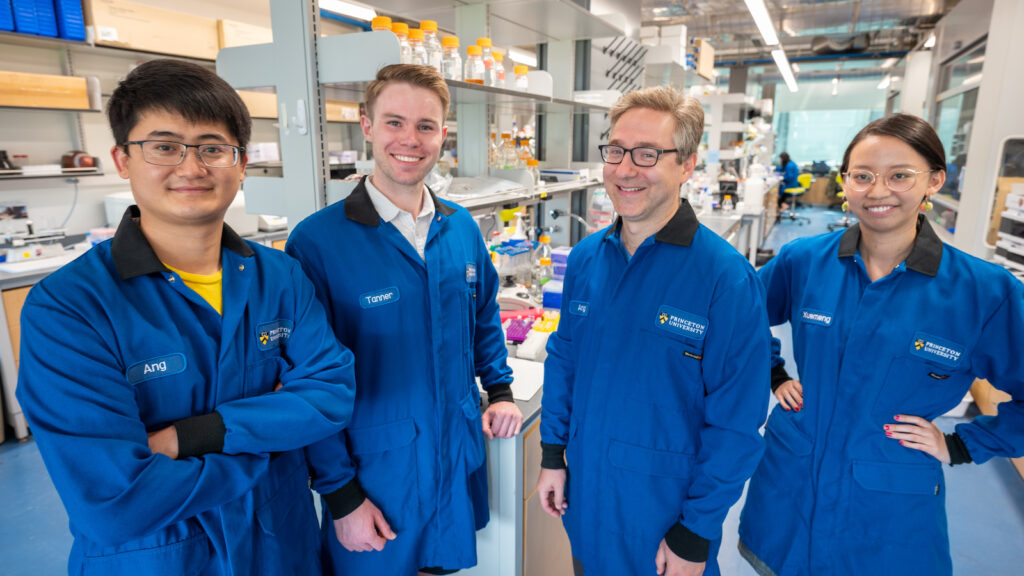Kleiner Lab investigates hm⁵C and f⁵C in human RNA

Continuing their investigations into how chemical modifications on RNA impact function, researchers in the Kleiner Lab adapted a chemoproteomic strategy they developed last year to characterize RNA 5-methylcytidine (m5C) dioxygenase enzymes in human cells. They were able to show that ALKBH1, which is responsible for multiple cellular functions, is the major enzyme oxidizing m5C to 5-hydroxymethylcytidine (hm5C) and 5-formylcytidine (f5C) in a variety of tRNA and mRNA substrates. They show that they could use 5-ethynylcytidine (5-EC) to capture these types of enzymes and investigate the distribution and biological function of hm5C and f5C modifications throughout human RNA transcripts.
Publication:
Nature Communications, “Reactivity-dependent profiling of RNA 5-methylcytidine dioxygenases,” published July 2022.
Authors:
Emilia Arguello, Ang Li, Xuemeng Sun, Tanner Eggert, Elisabeth Mairhofer, and Ralph Kleiner.
How they did it:
Last year, the lab announced a strategy to profile RNA modifying enzymes in living cells: RNA-mediated Activity-Based Protein Profiling (RNAABPP). Through the strategy, a cell is essentially tricked into picking up artificial molecules—a chemical probe—and putting it into its RNA, which then serves to track and capture RNA modifying enzymes.
By changing the structure of the chemical probe, researchers can change the “flavor” of the experiment to capture different enzymes.
In this paper, researchers changed the chemical structure of the probe to 5-ethynylcytidine, which allowed them to investigate the little-understood m5C oxidizing enzymes. These types of enzymes are generally considered to have biological significance because they are found in most organisms. The lab achieved their results through metabolic labeling and activity-based crosslinking to identify the human enzymes, combined with RNA mass spectrometry and sequencing to investigate their associated RNA modifications.
What the enzyme is doing:
The investigation revealed that the translation of leucine codons—one of the 20 main amino acids—depends on ALKBH1-installed modification on tRNA, which implicates these modifications in protein translation. In addition, hm5C and f5C modifications were found across a variety of RNA transcripts including messenger RNAs. In short, ALKBH1 is the major m5C dioxygenase in human cells.
Quote from P.I. Ralph Kleiner:
“We proposed and showed that you could use 5-ethnylcytidine (5-EC) to capture these types of enzymes. We chose that structure because we hypothesized that it would react with m5C oxidizing enzymes, and found that in fact it does.
“One of the ideas about why it is important to have these types of enzymatic modifications on RNA, protein, DNA—any kind of biomolecule, really—is that they can function as a dynamic regulatory switch. So you can imagine that if you can affect enzyme activity and corresponding modification levels, then you can essentially tune whatever the downstream processes are. I think where this research is headed to is that these ALKBH1-dependent modifications (and most likely many RNA modifications) are a way to modulate translation and control protein production in response to certain cues.”
Quote from lead author Emilia Arguello:
“Using a collection of techniques such as chemical proteomics, quantitative mass spectrometry, and very tailored forms of sequencing, we were able to validate the presence of f5C in other parts of the transcriptome, trace a more comprehensive map of its biogenesis, and expand on its function in tRNAs.
“The key, I believe, was to approach the problem from a chemical perspective. We chose to start by targeting the cellular chemistry that generates this modification, chemically high-jacking cells and tricking them into telling us where else this mark might be present. I think going after the chemistry as a first step gave us solid ground to stand on and options to build the most substantial story.”
Quote from co-author Ang Li:
“Our work reported the presence of f5C sites across the human transcriptome—ALKBH1 not only works on tRNA, but also mRNA.”
FUNDING:
This research was supported by funding from a National Science Foundation CAREER award (MCB-1942565), the National Institute of Health (RO1 GM132189), the Sidney Kimmel Foundation, and the Alfred P. Sloan Foundation.
